A drive in the Mercedes EQXX showed me why you should no longer accept range anxiety
Why was everyone pointing at the car?

It’s no secret that I’m clueless when it comes to cars. Just look at the time I nearly got stranded in Italy because I didn’t know how to restart a hatchback after getting lost at a toll.
Or the time that I just couldn’t work out how to restart another car when stopping for a lovely little break at the side of the road… actually, most of my misdemeanors revolve around not being able to start really high-end vehicles.
So, it was with a slight amount of trepidation that I accepted Mercedes’ invite to come and check out the new Vision EQXX, the one-of-a-kind concept that's just managed to do 1200KM / 740 miles on a single charge - I was going to ruin something, wasn't I?
Now, I’ve been writing about tech for 15 years, getting more easily jaded as the announcements roll by. Another launch, another incremental change.
So I was unprepared for the infectious enthusiasm of the Mercedes team over what they'd achieved with the EQXX. The goal was given 18 months ago: create a road-legal car that could go further than any other electric vehicle made, and make it look good in the process.
What emerged was a moment in electric car history, no doubt.
“Basically, we started off with what the colleagues are working on for the next compact class generation, an engine that's being built in house,” said EQXX project manager Malte Sievers.
Get daily insight, inspiration and deals in your inbox
Sign up for breaking news, reviews, opinion, top tech deals, and more.
“And then we just turned it up to 11, in terms of the efficiency on everything that didn't align with what we're trying to do [for production cars]. Obviously, we do have a very specific use case with this car. And, yeah, we just went all crazy on efficiency with it.”
I'm constantly surprised at this EQXX showcase - at every turn, I'm greeted with excitement from someone showing off this new car, something that I'd never have associated with a project from an efficient corporate behemoth.
But this EQXX project is spoken about in more hushed, vibrant tones: every member of the team that worked on it - from the overall concept to the screen inside - is visibly proud.
This is a car that was conceived in the heart of the first Covid lockdown, and only recently realized. It's road-legal, but not in production in order to make sure it could be made quickly.
And I got to watch the people behind it meet for the first time - spotting a face or two light up when they realized that they were meeting 'that person from the Zoom' calls and embracing, taking pictures of the car they made and just smiling the entire time.
The Mercedes VIsion EQXX is so obviously a branding exercise, Mercedes showing off its engineering talent - but this is also a car that's had so much love and attention poured on it too.
Palpable enthusiasm
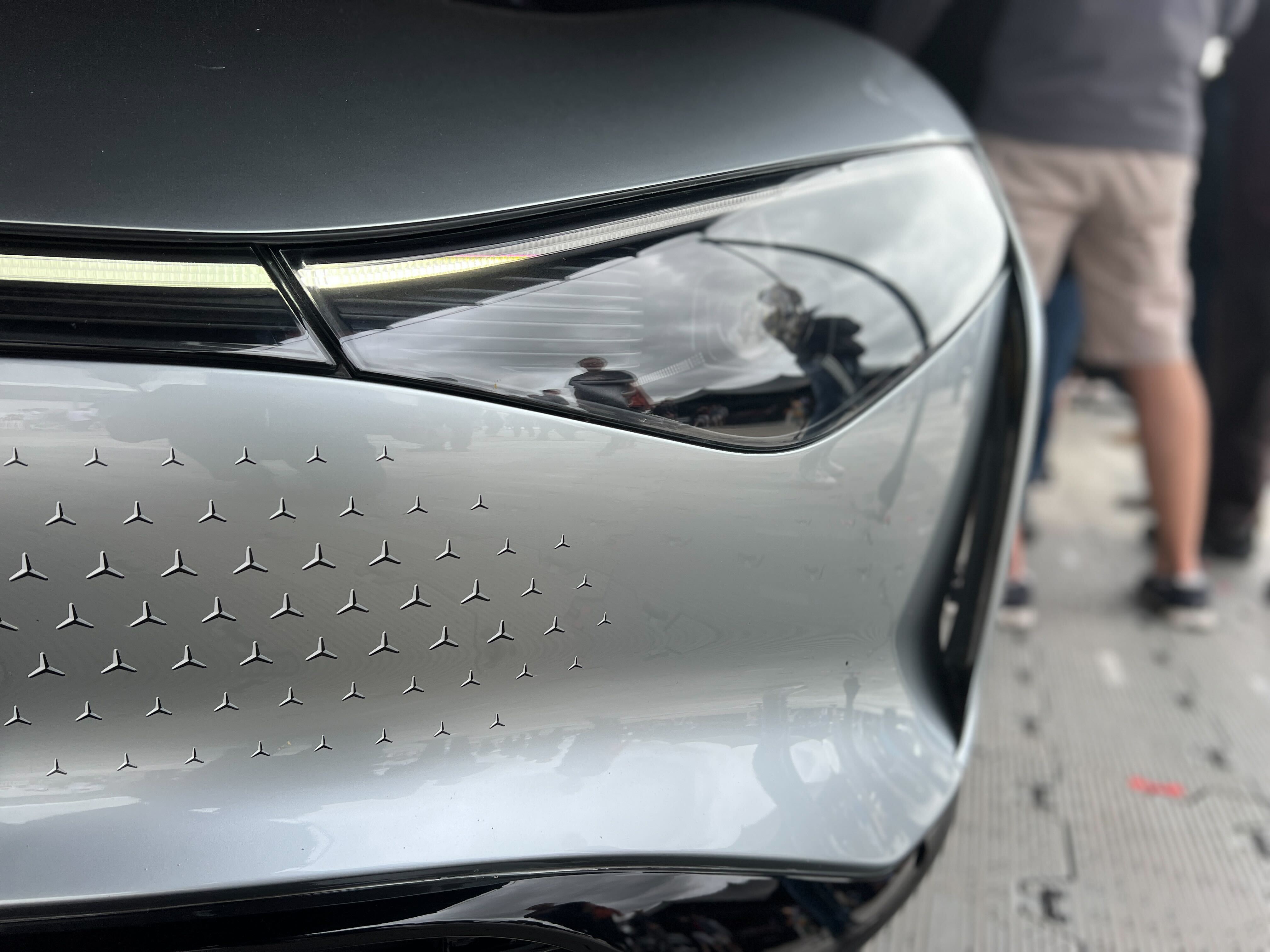
As I said, while the 1200KM+ performance of the EQXX is impressive, it's clearly a marketing exercise above all else. Mercedes wants to demonstrate to the public what it can do in the electric space.
As incoming legislation in many countries means that manufacturers will no longer be able to sell petrol and diesel cars in the 2030s, cue a rush of brands all vying to show their prowess in building the best electric car and rapidly increasing their efforts into dispensing with petrol power.
“To be honest, it took me a lot of time until I really got [the EQXX project],” admitted Sievers, who hasn’t been involved in these high-end concept cars in the same way before, and was slightly puzzled about the duality of the project.
So why do it this way? Why make a car that feels ready to hit the road when a concept like this could have gone so much further?
“I wouldn't have thought that [the EQXX] has appeal because it looks sporty to me, right? But it's not a super fast vehicle, right? It's limited to 140km/h.
“But nobody is concerned that it's a slow-ish car or something like that. People get this concept, this overall story. And I think [having achieved a car that can last over 1200km on a single charge] really helps everything going forward.”
Sievers told me that the achievements of the team had raised the bar in terms of what was now considered possible within Mercedes.
The EQXX ran an average power consumption of 8.3 kWh/100 km in its latest test (in real world, high-traffic and hotter-than-usual temperatures), which is over twice as efficient as the average electric car - and it’s in the fiddly details of finding that efficiency that Sievers, like so many at Mercedes, gets visibly excited when talking about the car.
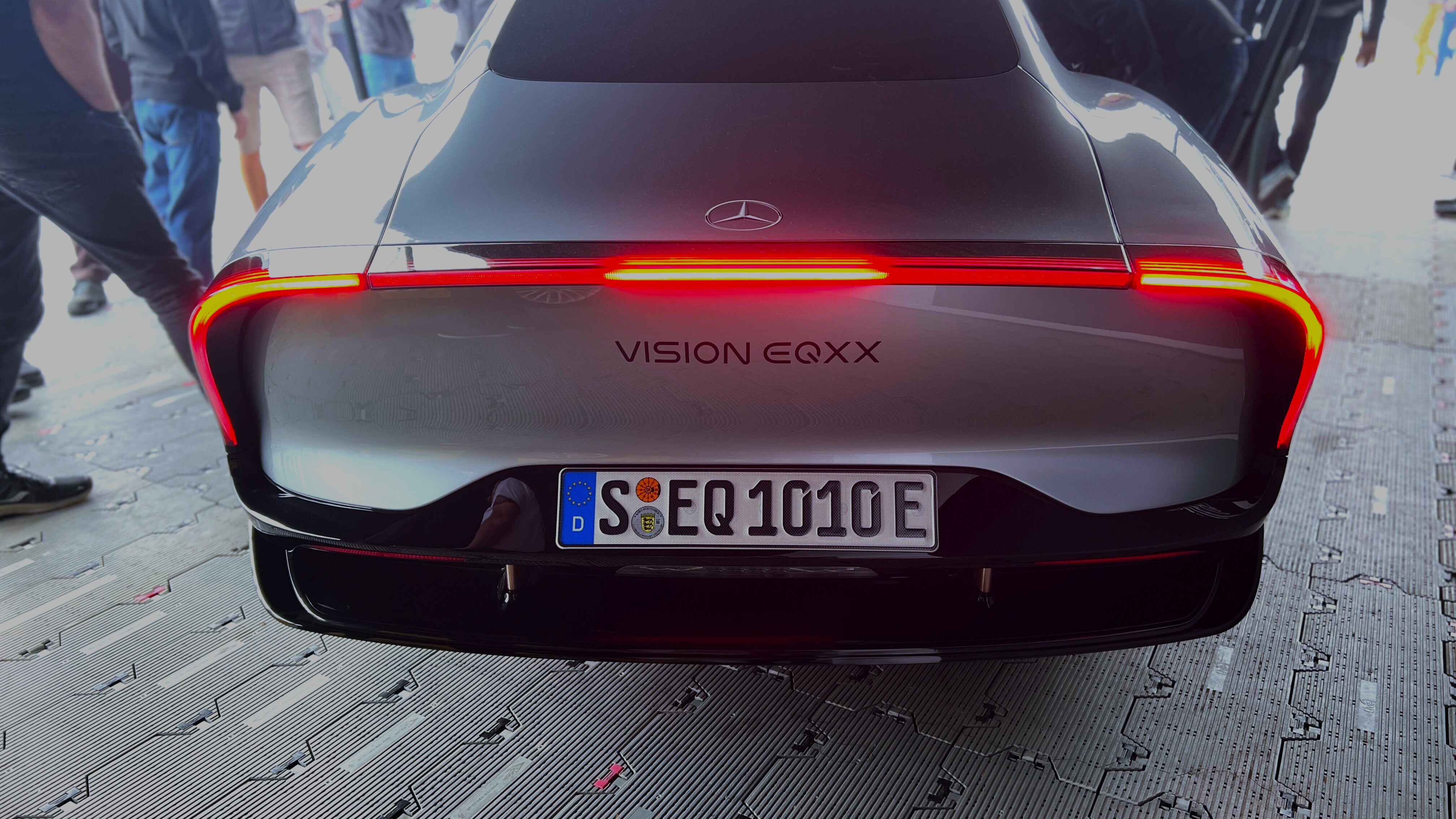
I get a thorough walkaround that takes well over 30 minutes, constantly being stopped and treated to stories on how the most minute features came to life. So much of the efficiency gains, which were much-needed to eke out more range, came from myriad smooth aerodynamic stylings over the car with creative engineering ideas behind them. Mirror sensors? Gone. Elongated, movable diffusers? They're in.
It’s rare that a manufacturer - and especially one as media-trained as Mercedes - will be so forthcoming about a project, but the communal achievement of making a car that’s broken expectations of just how far it can go seems to have lifted the barriers somewhat.
We talk at length about the automatic diffuser that extends from the rear at certain speeds and how that massively increases efficiency and stability. I hear about how the battery is thermally insulated... which is apparently unheard of.
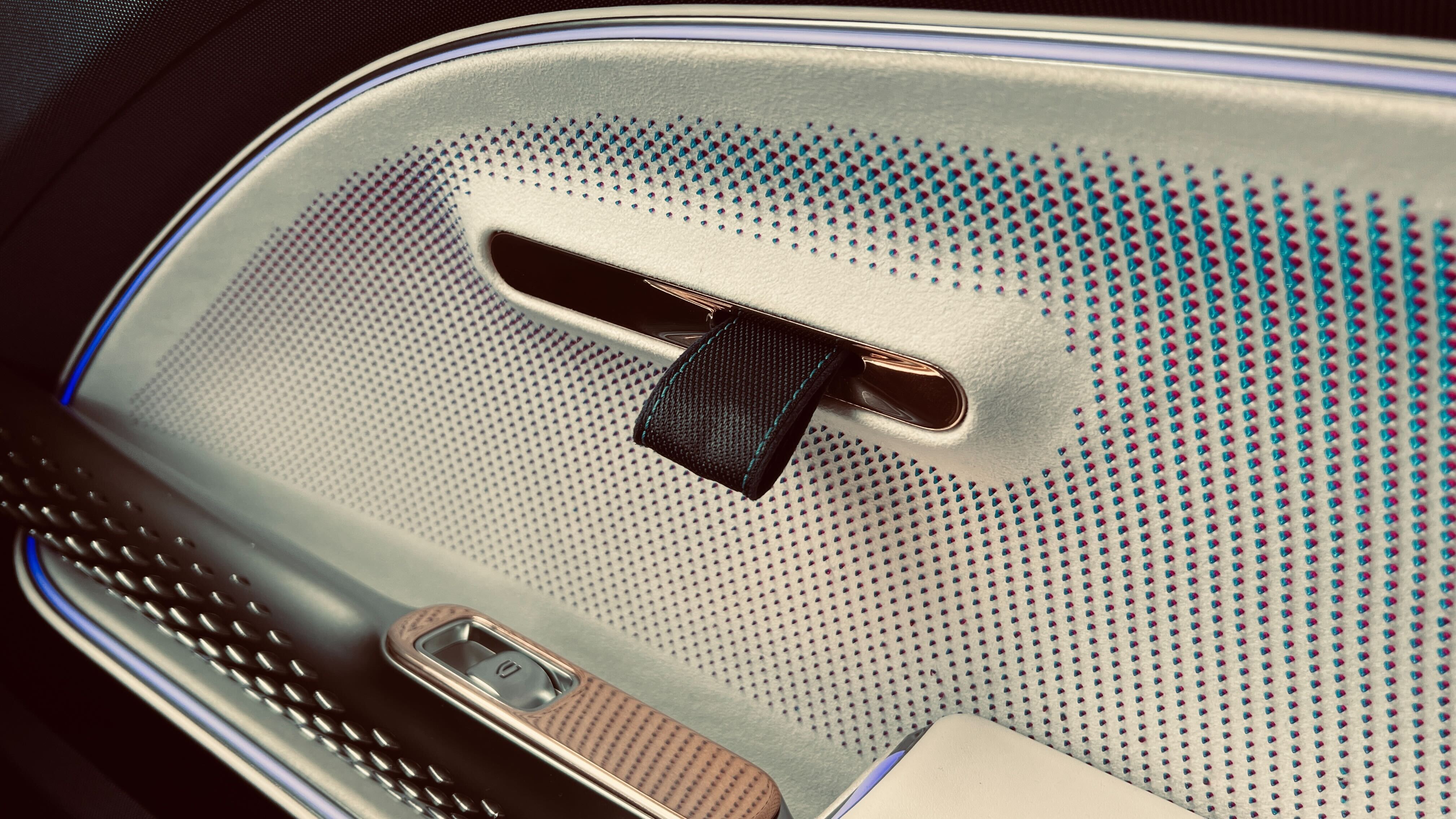
Sievers gets as excited about the lack of rain ridge in the windscreen as much as the hyper-efficient battery inside the car - this wasn’t a corporate exercise to him, it was an engineering challenge, the kind of thing most people working in the car industry would love to be unleashed upon.
Is it cheating?
I was curious about the end result: the EQXX is a beautiful car, with elegant, swooping stylings. But I was expecting a shell inside, with every single element stripped of weight and function to achieve maximum range.
Nope. The interior contains things like faux-silk handles, sustainable materials made from fungus and cactus, luxurious carpet made from recycled bottles and tiny 3D-printed cones inside the door (that I’m told not to touch as they could break off - I decide not to mention I’ve been running my hand up and down them).
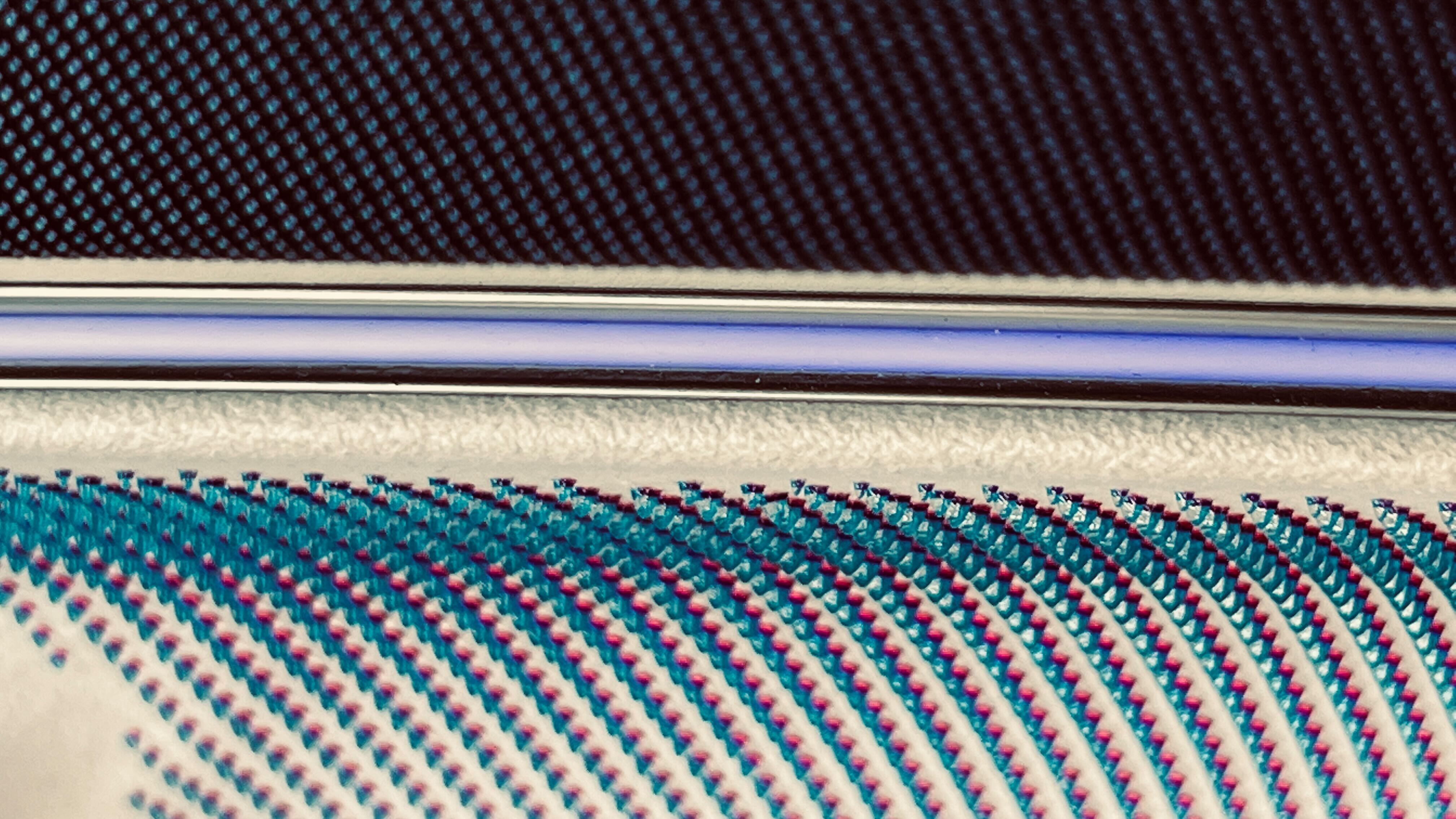
The dials and dashboard are replaced with a futuristic pillar-to-pillar 8K, mini-LED touchscreen 'Hyperscreen' display that spans the entire cockpit... surely this is entirely overkill when the goal is to make the EQXX go as long as possible on a single battery charge?
"We don't wanna make it look shit"
Steffen Köhl
So why do it this way? Why make a car that feels ready to hit the road when a concept like this could have gone so much further and posted an even more headline-worthy distance… maybe even beating the world record for an electric vehicle was set in 2017, using a reclaimed BMW and huge battery?
"We could have done things like use analogue dials [in place of the Hyperscreen], but that would be cheating" shrugs Sievers.
That word 'cheating' is used a lot in our conversation, this idea that the 'game' here is that the EQXX needed to be close to something you'll be able to buy, rather than an exercise in engineering that promotes function over form.
Mercedes wanted to make something ‘believable’ as a car that could one day appear on the road - which makes me think that, despite the protestations of all the engineers and executives, that we’ll see something closely resembling the EQXX on the road in the next year or two.
An underwhelming entrance
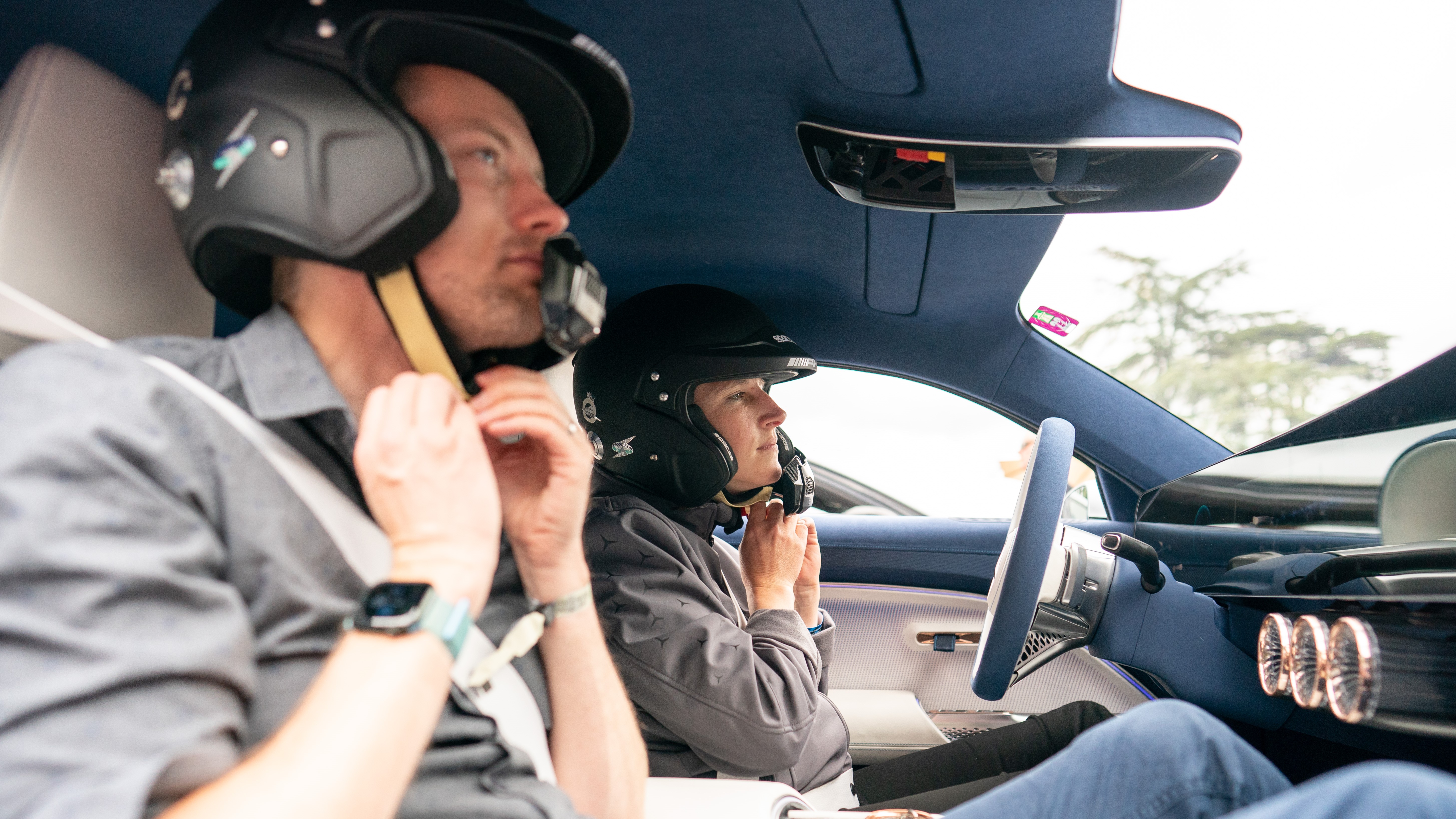
Now comes the good bit: the chance to see how the car actually drives as I'm going to get driven up the iconic Goodwood Climb, a section of track that roars past throngs of spectators and haybales, screaming too close to a stone wall and threading through tree-lined sections.
I slide into the surprisingly high-roofed car (I’m 6’2, and was able to sit in comfortably) and head to the track with Eva Geriner, the chief engineer of electric drive systems, a high-up bod at Mercedes who also worked on the concept car’s creation.
We crawl out of the Mercedes stand, and people start looking. I assume that it’s the stylings of the silver car that’s causing the gawping, but that doesn’t make a huge amount of sense given I’m at a festival that has literally hundreds of iconic, weird and classic cars from all eras.
The EQXX is nice, but it's hardly stand-out visually compared to classic Ferraris or 1960s hypercars. And they're pointing at the floor.
We come to a shuddering halt. Not because the car has broken down, but because we've just entered the huge queue that cars must enter before hitting the Climb.
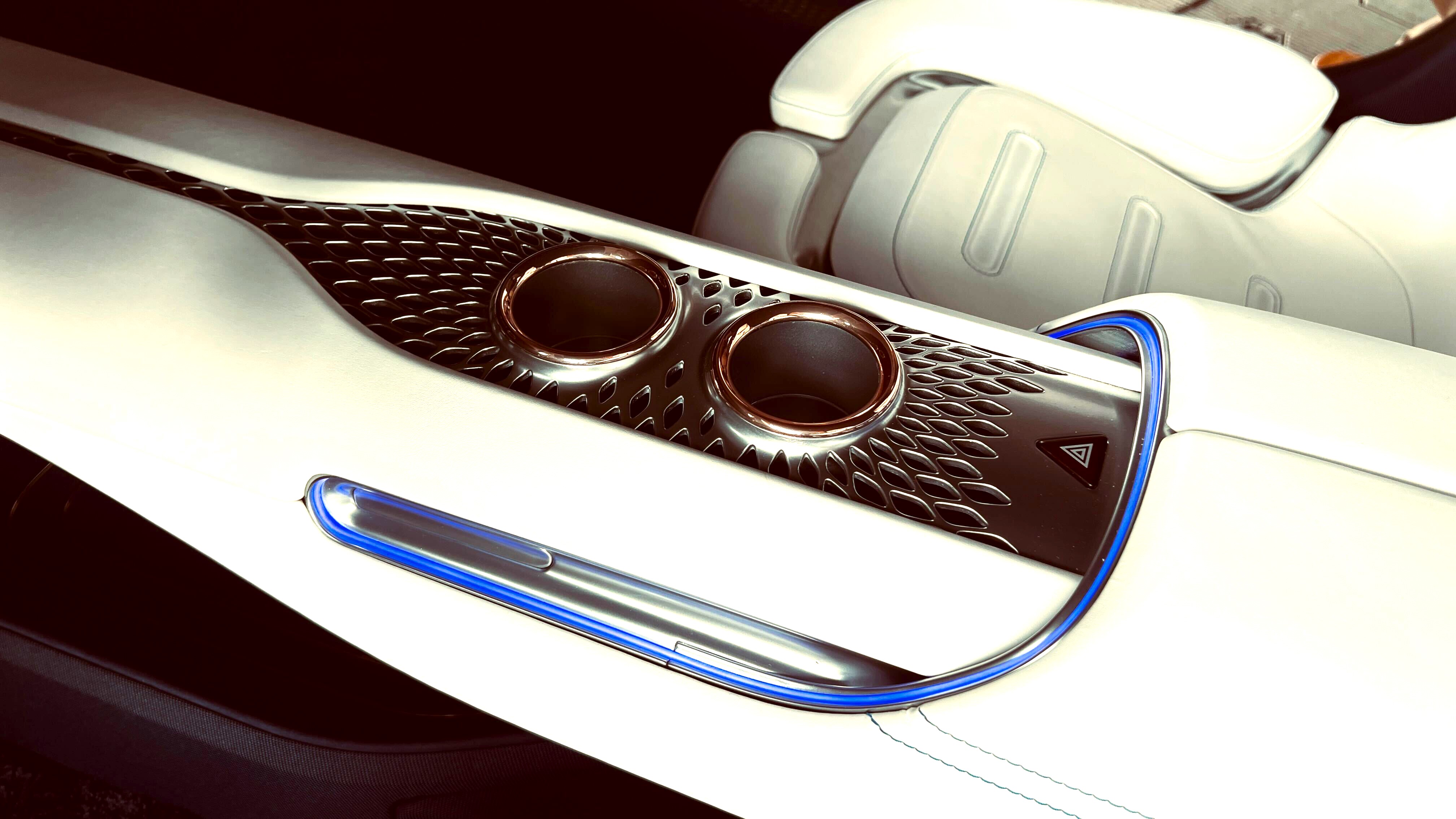
What I think will be a few minutes turns into an hour - so I get a long time to acquaint myself with the interior.
A few things leap out at me: you can see where the design and engineering teams butted heads on this car. For instance, the central console has drinks holders barely big enough for a thin can of drink, but smoothed so elegantly into the interior that it's clearly a design choice.
I begin to poke away at the Hyperscreen, to see what it can do. I know that it’s powered by an unnamed gaming engine, that it uses a 3D world as a UI… it can work as one seamless display or split into chunks: dials for the driver, media entertainment for the passenger.
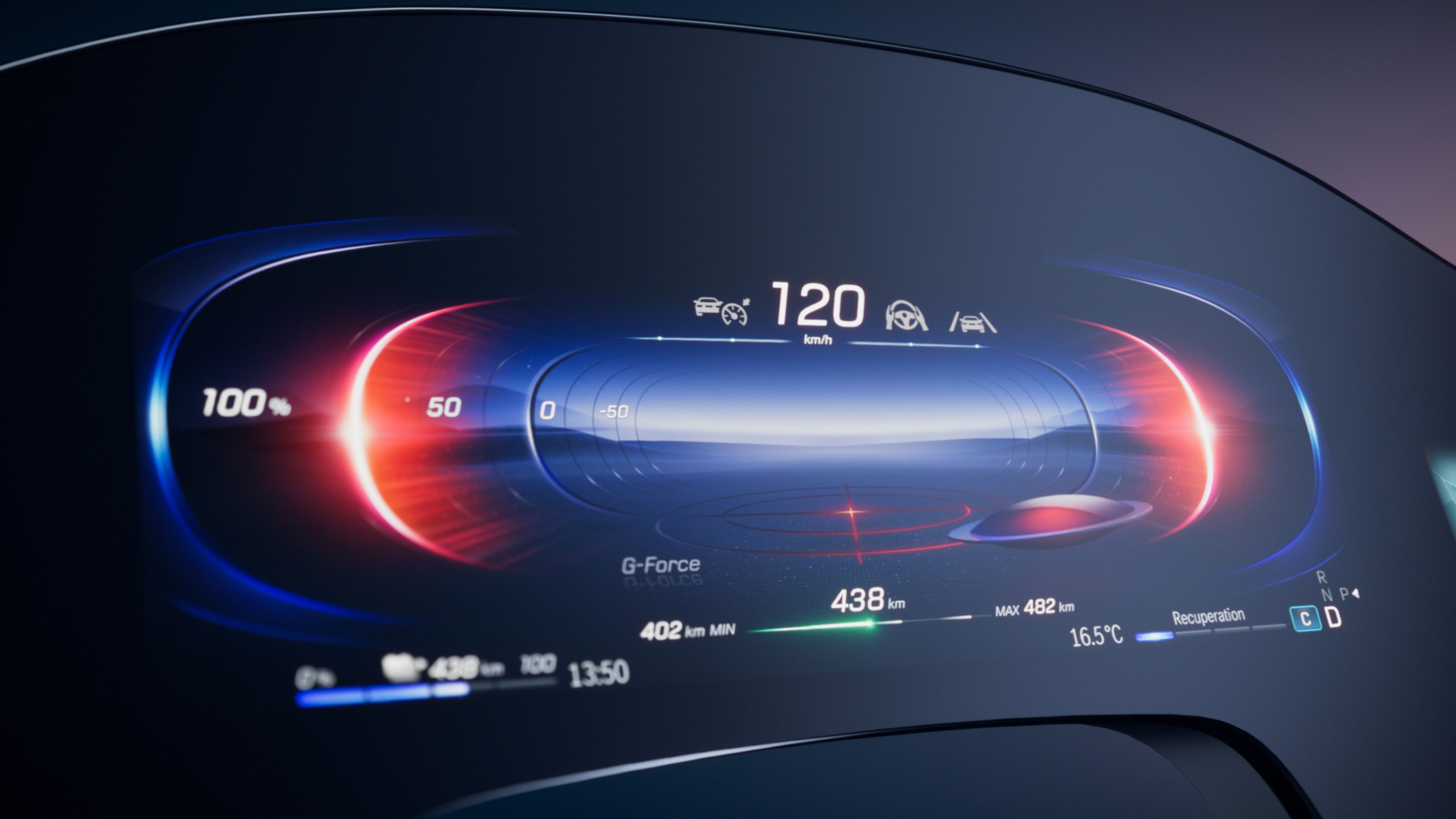
It’s in this media section that I fire up a video about the origins of the EQXX and find out another reason why the car has such an odd affinity for high-end stylings, completely at odds with stripped-down ‘The Phoenix’ car that set the EV record in 2017 and went further on a single charge than Mercedes' effort:
"We don't wanna make it look shit" says Steffen Köhl the Director of Advanced Exterior Design. I guess that attitude made some design meetings
The Hyperscreen is OK - it's not the smoothest to the touch, but I'm told that slightly unresponsive feeling under the finger is designed in to avoid false touches when driving, but I think it just needs more optimization when it lands in production cars.
What I found myself yearning for was a screen that wrapped around the whole dashboard. Something that uses flexible electronics to curve up towards the windscreen, folding into the pillars itself.
That would have been folly for this car, where every component had to be designed without superfluous weight, which is why a mini-LED system was used, as it's lightweight but still creates the rich, colorful and deep graphics on the screen.
But a more responsive, impactful screen has got to be the direction that Mercedes goes if (or really, when) the EQXX makes it to the production in the future.
The pointing continues
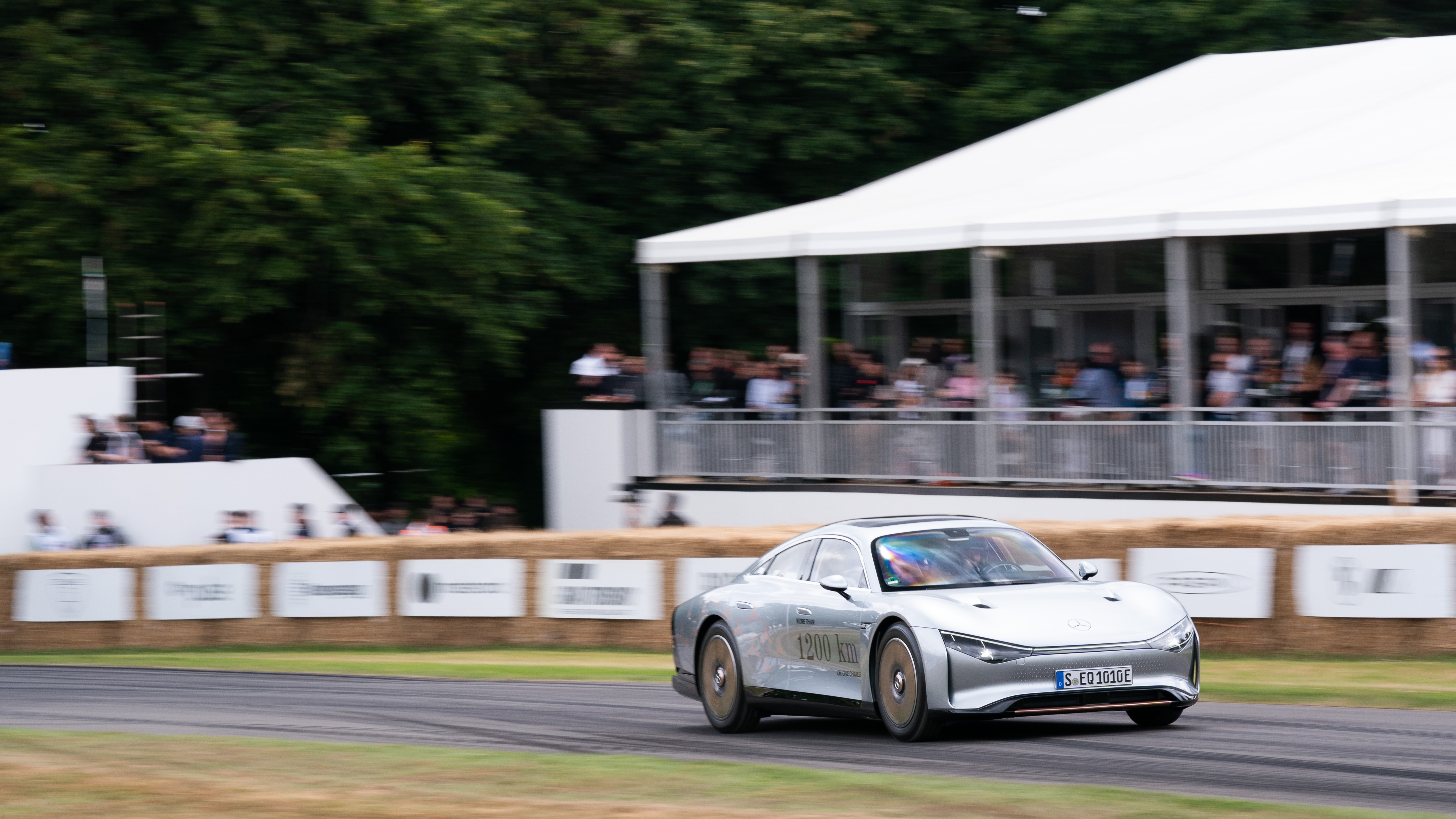
Finally, we get the nod. We’re heading to the track, and I’m trying to raise my excitement. Usually, my heartbeat would be through the roof at the prospect of taking a super car on an iconic track, but I also know that this is the only Mercedes EQXX in the world, and crashing it would be a Very Bad Thing.
I was told this was going to be a 'comfortable, elegant drive' on this section of track that's seen the world's greatest drivers try to speed through as fast as possible, so I've lowered my expectations of it feeling thrilling. That's OK. I’ll take any chance to be on this course.
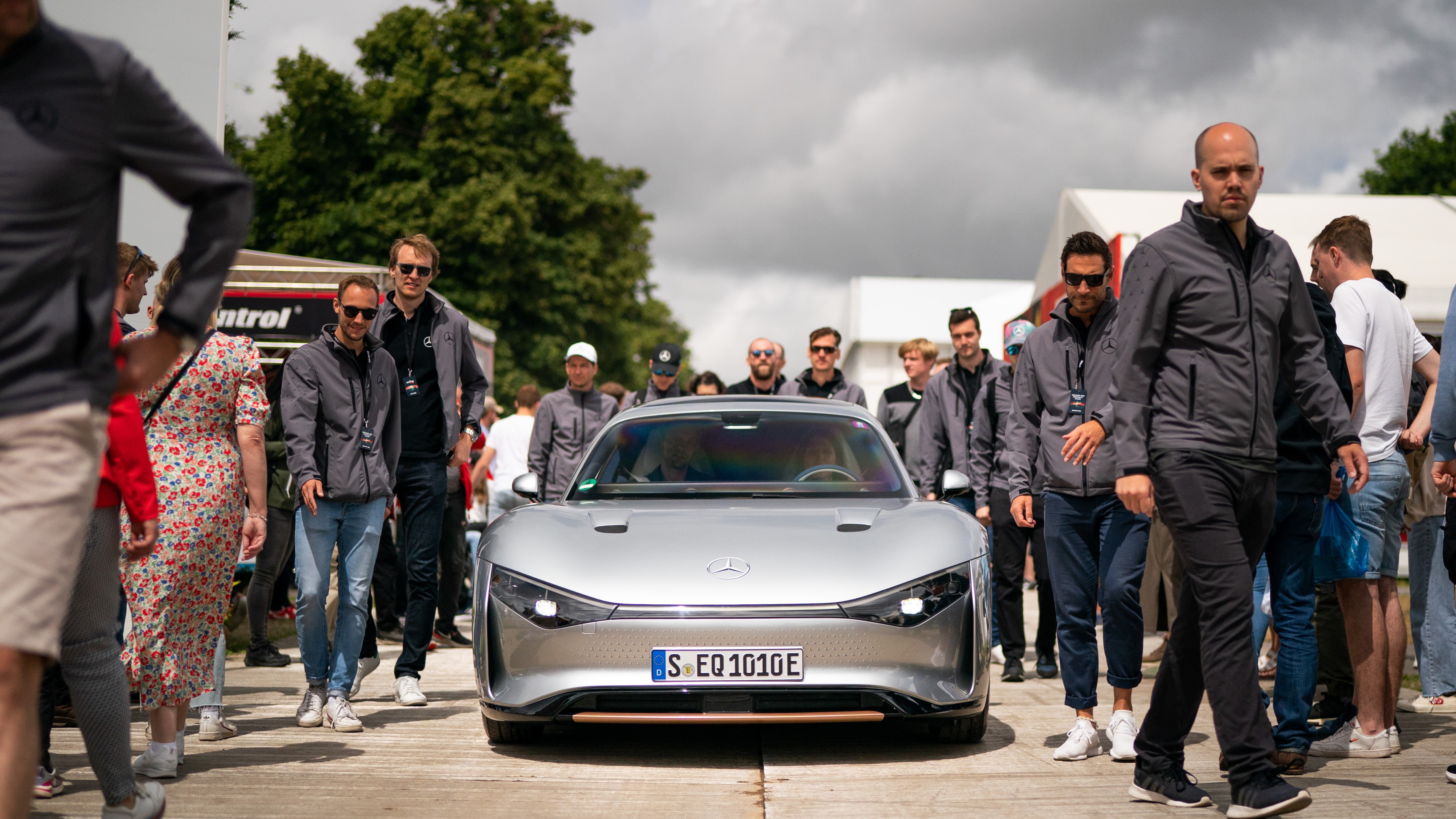
But out of nowhere, we’re off. The car accelerates away hard, and I'm actually shocked as I get pinned back in the seat.
As we open out in the grandstand sections, the EQXX is certainly not being thrown around - but suddenly I can feel all the engineering that's gone into making this a robust supercar.
It’s not got the soft suspension of the new Mercedes EQE 350+, for instance… even through the passenger seat I can feel the rigidity and lightness of the frame warring with the raw power coming from the drivetrain, the nimble steering as we flip past the stone wall and into the wooded section making the climb feel fast.
I can feel that Eva wants to push this car a little harder as she slams on the acceleration down the straights before taking it easier through the twisty sections - in fairness, she’s never driven this course, but delivers such a confident drive that I'm genuinely sad when I see the finish line appear far too soon.
We then turn and trundle back to the pits… and people are still stopping and pointing at the floor of the car. I don’t remember it being particularly standout as a design, but then I realize what they’re actually looking at.
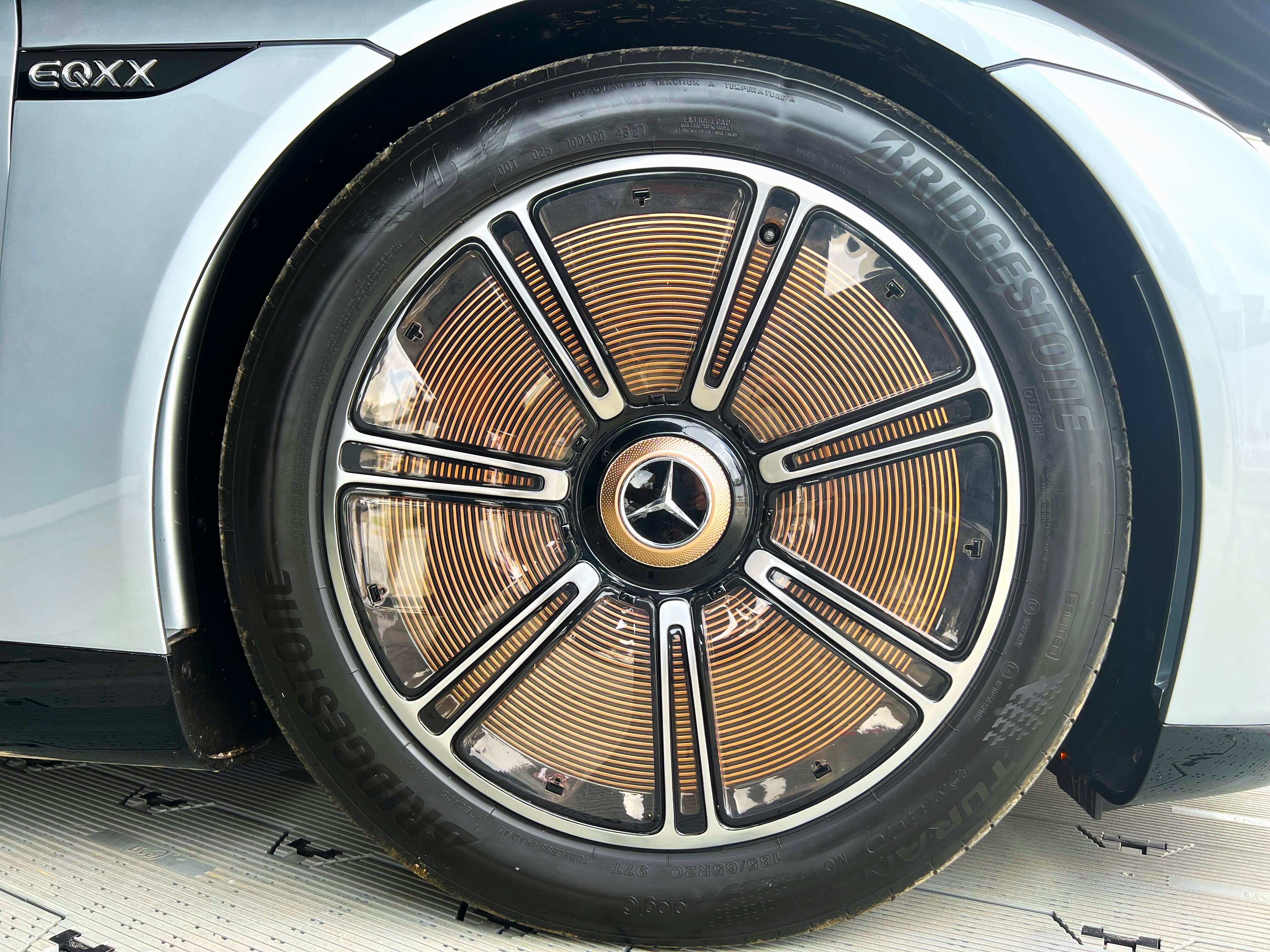
On the side of the EQXX are emblazoned the words ‘More than 1200km on one charge’ - that’s what everyone is staring at with wonder. While I knew it was a big, historic number for electric vehicles, I didn’t think it would mean too much to this petrol-obsessed crowd.
I was wrong. This is a literal head-turning number… so, it turns out, it wasn’t the compact, sporty car that people were interested in - it was how far it could go.
I was left feeling wistful that Mercedes had focused so hard on making this car look good rather than being able to go as long as possible on a single charge, especially as it’s not (officially) going to appear in this design as a mass-production car.
But...there’s possibly more to come.
Sievers tells me the speed is only limited to achieve better efficiency, that it's all about finding the balance between distance and performance.
So there's more tinkering to come - will Mercedes retool the EQXX to hit 250km/h? Will there be a track day when it's 'hypermiled' to get a true idea of distance it can go on one charge?
But then again, seeing the unbridled glee on the faces of the engineering and design teams that worked on the EQXX, maybe this is the right balance between the two.
I’m pretty sure enough people would buy a high-end sports car that can run 700+ miles on a single charge as that’s a huge selling point… and let's not forget, this car can drive too.

Gareth has been part of the consumer technology world in a career spanning three decades. He started life as a staff writer on the fledgling TechRadar, and has grew with the site (primarily as phones, tablets and wearables editor) until becoming Global Editor in Chief in 2018. Gareth has written over 4,000 articles for TechRadar, has contributed expert insight to a number of other publications, chaired panels on zeitgeist technologies, presented at the Gadget Show Live as well as representing the brand on TV and radio for multiple channels including Sky, BBC, ITV and Al-Jazeera. Passionate about fitness, he can bore anyone rigid about stress management, sleep tracking, heart rate variance as well as bemoaning something about the latest iPhone, Galaxy or OLED TV.